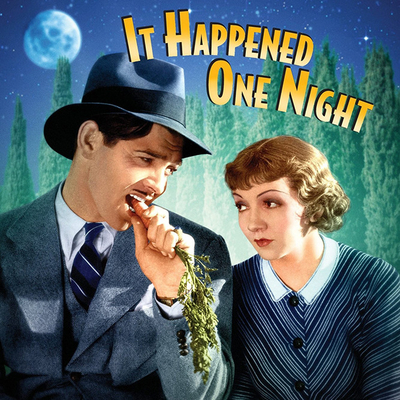The 1933 Oscars were one Frank Capra wanted to forget. The director had his hopes pinned on Lady for a Day, his bathos-drenched comic drama about a fruit seller and her socialite daughter; Capra had an unfortunate tendency to invest more emotionally in his ambitious flops and disregard the pictures that would make his reputation.
The film was nominated four times but had lost twice when Will Rogers opened the envelope for best director and said "It couldn't happen to a nicer guy. Come on up and get it, Frank." Unfortunately, Rogers was addressing Frank Lloyd, the director of Cavalcade, and Capra made a spectacle of himself, jumping out of his seat and shouting "Over here!" when the spotlight didn't seem able to find him.
"I wished I could have crawled under the rug like a miserable worm," he said later.
Just over a year later he was at the Biltmore Hotel on Pershing Square in downtown Los Angeles when his next picture, It Happened One Night, was nominated for five Oscars. That night would erase his humiliation after the previous ceremony, as the film would sweep all five categories, winning awards for Capra, Clark Gable, Claudette Colbert, writer Robert Riskin and Harry Cohn of Columbia Pictures. It would be the first film to manage this coup and wouldn't be matched until One Flew Over the Cuckoo's Nest in 1975 and The Silence of the Lambs in 1991.
Made at the end of the pre-Code era but released after the Production Code came into effect, It Happened One Night is considered a pivotal film, not just as the picture that helped set the template for the screwball comedy, but one that did a lot to launch the best part of the careers of Capra and its two stars. It was a transitional picture in all senses of the word, and remains the best remembered of the dozen films nominated for 1934's Outstanding Production (as Best Picture was once called), beating out both some respectable competition (Imitation of Life, The Thin Man) and some real footnotes (Flirtation Walk, Here Comes the Navy, The House of Rothschild, Viva Villa! and The White Parade.)
In Best Pick: A Journey Through Film History and the Academy Awards, all three co-authors agree that there's no contest. Tom Salinsky notes that cineastes will prefer Jean Vigo's L'Atalante (even though it wasn't released in the US until 1947) but concurs with John Dorney ("I really can't give the Oscar to anything else.") and Jessica Regan ("I adore this film, and I applaud the Academy's choice heartily.")
Among Capra's achievements was helping invent the "runaway bride" story, and the film begins with the bride. Heiress Ellen Andrews (Colbert) has locked herself in her cabin on her father's yacht and is refusing to eat until he acknowledges her quickie wedding to King Westley (Jameson Thomas), a social-climbing aviator who her father calls "a fake." He tries to cajole her with a forkful of steak, which she slaps away before flipping over the dinner on its tray.
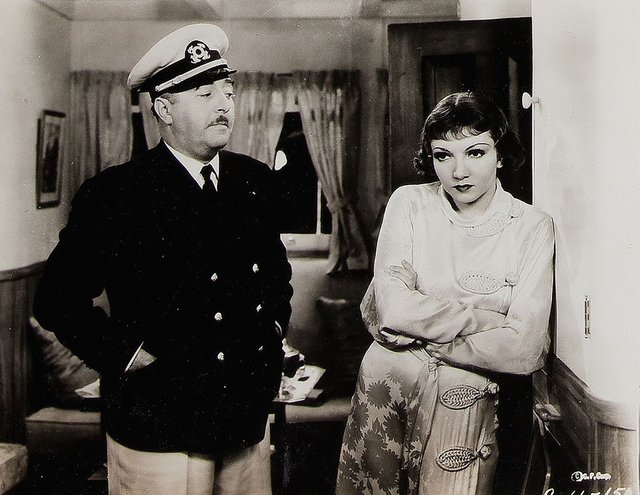
Her father slaps her, and the shock on both their faces tells us that this has never happened before; outraged, Ellie runs on deck and leaps into the water, evading the yacht's crew as she swims to shore. Character actor Walter Connolly does a fine job as her millionaire father; portraying the plutocrat with a heart of gold would be a specialty of his, and he would play it in Capra's Broadway Bill (1934) as well as Libeled Lady (1936) and Fifth Avenue Girl (1939).
After picking out Ellie waiting in the shadows trying to board the night bus to New York City without being spotted by her father's private detectives, Capra's camera shifts to Gable's Peter Warne, a newspaperman in a phone booth, drunkenly abusing his editor after handing in a story written in free verse, for the entertainment of a crowd of other newspaper hacks surrounding him. He quits the paper while his boss fires him, then marches in procession to the bus surrounded by his retinue.
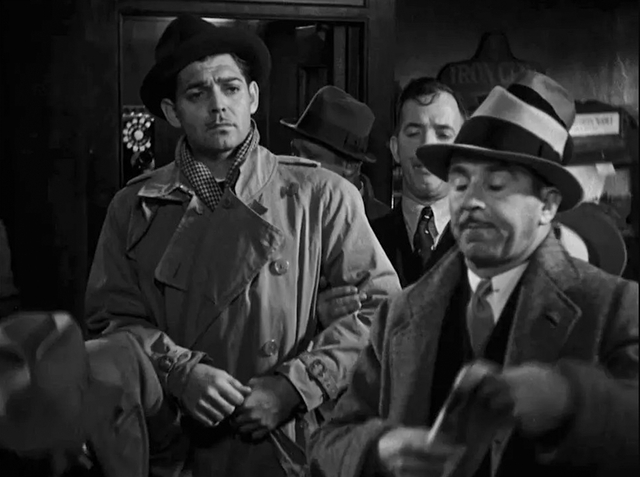
Ellie and Peter finally meet when they're forced to share the last seat on the bus, and the newspaperman decides to be her protector when he sees a sneak thief make off with her suitcase at their first rest stop. When he figures out her identity he makes a deal – he'll help her reach New York and her erstwhile groom if he gets to write the story and get his job back. The audience, of course, knows that they'll fall in love somewhere along the way.
The role of the runaway heiress had been introduced to the American public by celebrities like Barbara Hutton, who had married Prince Alexis Mdivani against her father's wishes just a few months before Capra and Riskin started work on the script, which had begun life as two short stories written by Samuel Hopkins Adams, published respectively in Collier's and Cosmopolitan – "Last Trip" and "Night Bus".
The rough-edged, uncouth newspaperman was only slightly older, and it would persist for years, a relic of the days when a college degree was a hindrance, not a requirement, for a job in a newsroom. (Ben Hecht's The Front Page made its stage debut in 1928 before being adapted for the screen by Lewis Milestone in 1931 and reimagined by Howard Hawks as His Girl Friday in 1940.) It's understood that a man like Peter will hide whatever refined sensibilities he has behind wisecracks and bluster. (He calls his editor a "gashouse palooka" over the phone.) They were both caricatures, but Gable had the advantage of being able to relax into a more capacious, well-worn one.
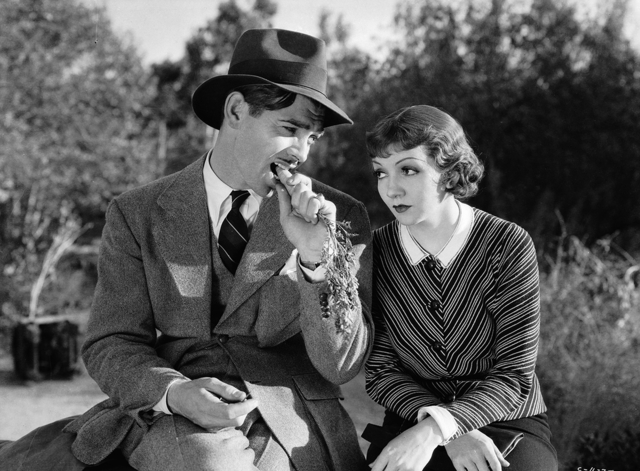
Capra was in a rough position when he made the film. He was Harry Cohn's golden boy at Columbia, but at a Poverty Row studio that was like being king of the rat's nest. He had just finished making a series of pictures with Barbara Stanwyck, who had been something of a muse as they were having an affair that began with Ladies of Leisure (1930) and ended when she decided to reconcile with her husband, Frank Fay, when they made Forbidden (1932).
(They would make one more picture together, Meet John Doe, in 1941, and the dark, fraught tone of that film amply suggests some lingering fallout from the affair, nearly a decade later.)
Casting the heroine was difficult as Capra sent a draft of the screenplay (still called "Night Bus") to Myrna Loy, Miriam Hopkins, Margaret Sullivan and Constance Bennett, who all turned it down. (Bennett apparently said she'd agree if she could produce the film. You can only imagine how well that went down with Harry Cohn.) Carole Lombard and Loretta Young were also rumoured to have been considered (Lombard was busy with Bolero, Young turned it down), and Bette Davis (!!!) was interested, though Jack Warner refused to lend her to Columbia.
Colbert and Capra had worked together on her first film, For the Love of Mike (1927) and that hadn't gone well, but Cohn insisted they try to get her for the picture. It's hard to imagine the role of Ellie appealing to the glamourous Colbert; as Elizabeth Kendall writes in The Runaway Bride: Hollywood Romantic Comedies of the 1930s, "a self-respecting actress did not make a picture in just two costumes."
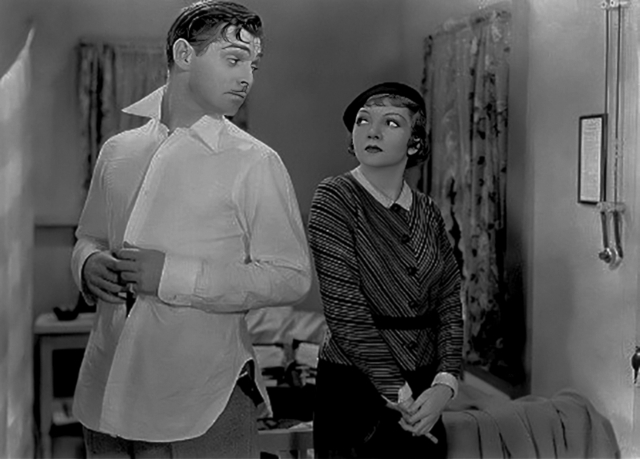
She'd had two big pictures with Cecil B. DeMille with The Sign of the Cross (1933) and Cleopatra (1934), but these typically lascivious DeMille pre-Code productions had lent her onscreen persona an unwanted camp veneer. Kendall writes that the actress saw an opportunity, and that "behind her charming exterior there lurked a shrewd and self-promoting mind. In signing with Capra she was simply seizing an opportunity that other actresses failed to recognize. Still, she was lucky that Capra saw through her charm to the intelligence that controlled it."
But Colbert made Capra and Cohn work to get her on board. She was on her way to Sun Valley for a vacation when they sent her the script and said that she'd only consider it if Cohn doubled her salary and Capra made it in the four-week window she had in her schedule. Amazingly Cohn agreed, and her salary would be $50,000 of the picture's $325,000 budget.
Colbert was also interested because Gable had been cast as Peter after Robert Montgomery had been offered the role. Gable had displeased Louis B. Meyer, who punished him by lending his heartthrob out to the Poverty Row studio. The actor showed up drunk for the first day of shooting.
The nature of the story helped Capra keep filming on time and on budget – it certainly helped that Colbert only had three costume changes and wears one sensible outfit for most of the picture. Most of the filming happened on small, cheap standing sets or on location near Hollywood. Many of the road scenes were filmed on what's now called Thousand Oaks Boulevard; it's hard to believe that Los Angeles once looked so rural.
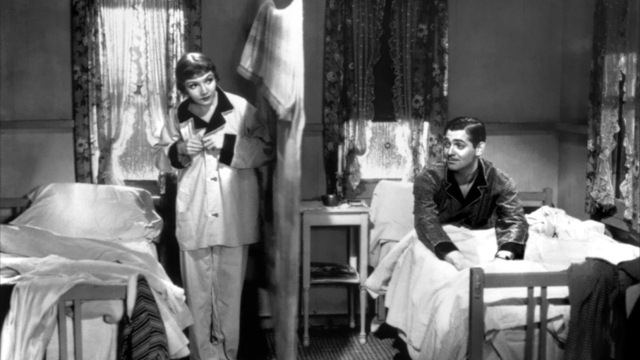
It took me several viewings to appreciate the accidental document Capra created of an itinerant, nomad America entering the depths of the Depression, as the night bus to New York makes its way north, with stopovers and accidents that require Ellie, Peter and the other passengers to find accommodation. The word "motel" hadn't caught on yet, and the rough little cabins and tourist camps with their shared outdoor showers are a long way from the modernist roadside motels, complete with swimming pools, diners and even supper clubs and bars, that would only proliferate when car ownership became common after the war.
The portrait Capra created of a desperate America and its citizens occasionally echoes the photographs of Walker Evans and Dorothea Lange, but as Kendall notes in her book, it would be a couple of years until their work was commissioned and distributed widely by the Farm Security Administration. He had to have sourced it from newsreels and his own memories of his hardscrabble life in the '20s.
Writing about the film in Romantic Comedy in Hollywood from Lubitsch to Sturges, James Harvey describes "the general drabness – the buses and bus stations, the dusty country roads and dilapidated cabins. A world of chintz curtains and traveling salesmen, of oilcloth and lunch wagons and outdoor showers. Populated by thieves, mashers and wise guys, sharpies looking for a fast buck, mean-faced housewives and their bratty children, truculent landladies and their quashed, compliant husbands."
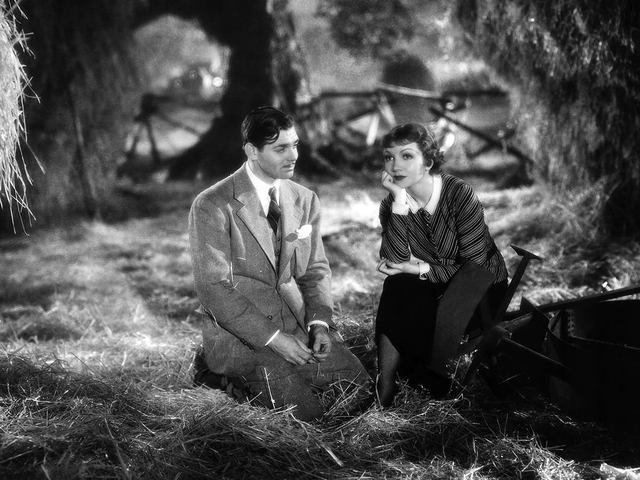
Ellie's naivete is what draws out Peter's chivalrous instinct, and she truly needs a protector, not just from the motormouthed come-ons from Shapely (Roscoe Karns), an annoying bus passenger, but from the man who makes off with her suitcase, and from the apparently jovial singing driver (Alan Hale) who picks them up while they hitchhike, planning on taking off with Peter's luggage. (He isn't fast enough to retrieve Ellie's suitcase, but he does run down the Model T, telling her that he left the road thief with a black eye, tied to a tree, when he returns at the wheel of his Ford.)
Gable's Peter is capable but it doesn't mean he's not desperate – perhaps more so than Ellie. "He's broke;" Kendall writes in The Runaway Bride, "he's out of a job; he can't even run fast enough to catch the guy who stole Ellie's suitcase. He's a surprisingly frank embodiment of the ineffectuality of the American male in the face of the Depression. He can do only one thing well: take care of someone who's lost."
Peter deals with this loss of agency with bluster; he's constantly telling Ellie about the right way to do things, and what's truly important in life. He insists that he's going to write a book one day – about piggybacks, and how to dunk a donut, and how to hitchhike properly.
"This hero," Harvey tells us, "may have the manners and style of a conjuror, a man who works magic, but what he is in fact offering to work is the prosaic and commonplace. He is teaching the heroine how to be ordinary, how to fit in, how to look and act like everyone else. Both the plot and her character require this lesson, of course, but still..."
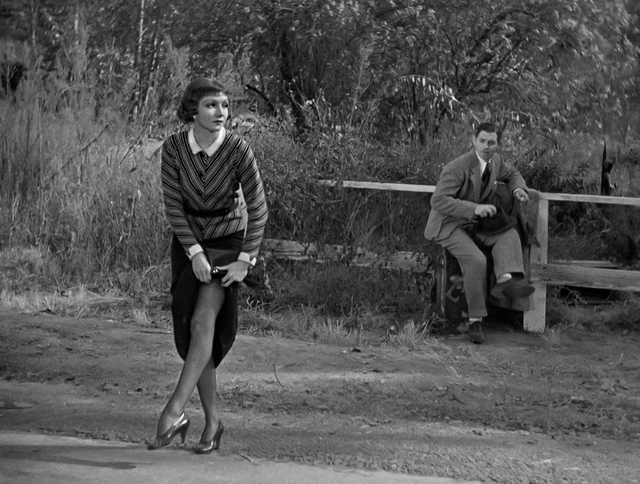
Which brings us to the film's iconic scene, and the one where the screwball heroine – or a facet of her – emerges in full view. They're alone on a dusty road and Peter's repertoire of sure-fire hitchhiking moves have flopped, to Ellie's cool amusement as she reclines elegantly on the top post of a fence. She gets down and tells her that she's going to stop a car "and I won't use my thumb."
She positions herself by the roadside and as soon as a car is within range she lifts her skirt as if to adjust her garter, arching her foot. Capra cuts from a shot of her leg to the driver's foot hitting the brakes, the tires on his car squealing and his hand pulling up on the parking brake. In the next scene Peter sits in the back looking sour, while Ellie is positively radiant. She has, as she told him, "a system all my own."
Colbert's contract with Capra insisted on nothing salacious (terms likely inserted after her experience with DeMille), but when she got a look at the chorus girl hired to be her leg double, she said there was no way she was going to let people think that was her and did the scene herself.
"In a way it's a pointless scene," writes Harvey, who uses it to explain the unique qualities of Colbert as a comedienne. "And it's so leisurely that we get to register things we haven't so clearly seen before in the styles of the two actors. Colbert's relation to objects, for example – the way she grasps them, settles into them. When she first perches on that fence, she clutches it with her hands and shifts her butt on it as if she were nesting into pillows – not so much a sensuous gesture as a practical one, an instinctive basic appropriation of an otherwise unwelcoming landscape."
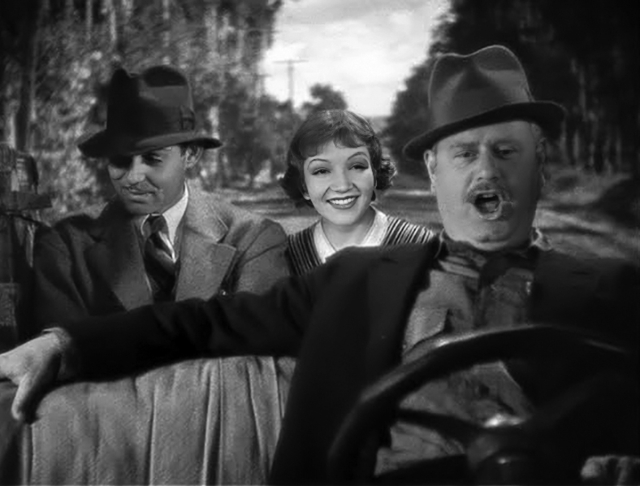
Colbert isn't your typical screwball heroine agent of chaos – at least not as someone like, say, Carole Lombard or Katharine Hepburn would embody her later. As Harvey writes:
"Ellie, we recognize, goes farther than he ever could: she is unconventional and he is not, for all his air of risk and bravado. She could have stopped forty cars if she'd taken all her clothes off, he reminds her sullenly as they ride along. 'I'll remember that when we need forty cars,' she says, with that same look of radian vacancy she had when she first stepped to the roadside. She is the magical one, then."
It's a quality that would serve her well in films like Bluebeard's Eighth Wife (1938), Midnight (1939) and especially Preston Sturges' The Palm Beach Story (1942).
It goes without saying that the film was as much a hit with audiences as it was with critics and Academy voters. It was a romantic comedy set against an economic calamity, and somehow it worked for the people (if not the Academy voters) who bought tickets. "Men in the audience had lost their jobs; women had gone to work," as Kendall writes in The Runaway Bride.
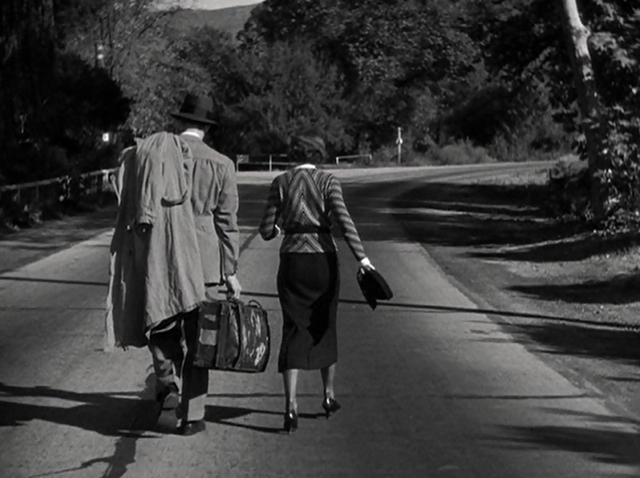
But when filming wrapped Colbert told friends that it was the worst film she had ever made. It's easy to understand why: Capra was not a favorite director and his script was deceptively simple. It would take his skilful editing and the abundant chemistry of the leads to make it work, and work it did.
Colbert was so sure that it would be a dud at the Oscars that she had to be dragged by Cohn's publicists from her seat on the Super Chief waiting to leave for New York to collect her statue. And unlike Ellie and the night bus, she persuaded the engineers on the train to delay its departure. "I am afraid I am just going to be very foolish and cry," she told the crowd at the Biltmore, then rushed back to Union Station to catch her train.
Club members can let Rick know what they think by logging in and sharing in the comments below, as access to the comments section is one of many benefits that comes along with membership in the Mark Steyn Club.


